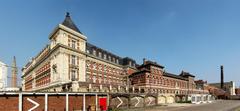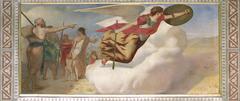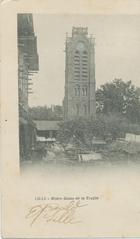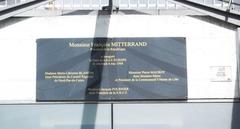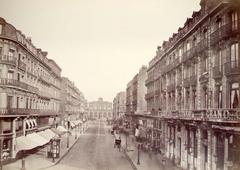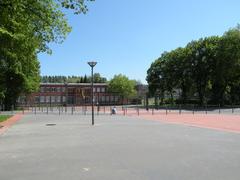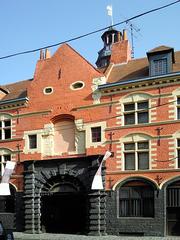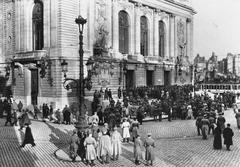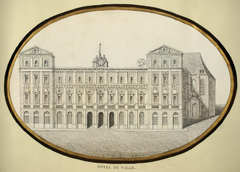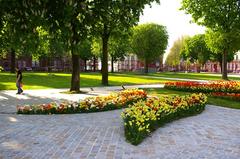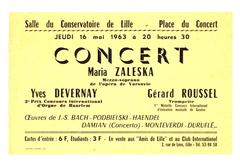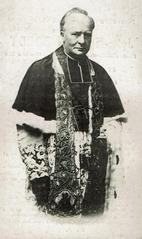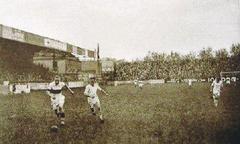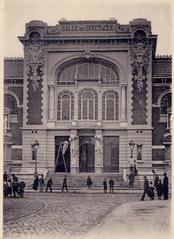
Avenue du Peuple Belge, Lille: Visiting Hours, Tickets, and Historical Sites Guide
Date: 04/07/2025
Introduction
Avenue du Peuple Belge, located in the vibrant heart of Lille, France, is a storied boulevard that beautifully encapsulates the city’s Franco-Belgian heritage, urban evolution, and contemporary vitality. From its medieval roots as a strategic river port to its present status as a pedestrian-friendly, culture-rich destination, the avenue weaves together centuries of history, architectural splendor, and community life. Whether you’re passionate about history, architecture, or urban culture, Avenue du Peuple Belge offers a compelling journey through Lille’s past and present.
For practical visitor information—including accessibility, guided tours, and upcoming events—consult official tourism resources (lille.fr), and explore immersive guides such as Audiala.
Table of Contents
- Avenue du Peuple Belge: Historical Overview
- Urban Transformation and Architectural Heritage
- Contemporary Redevelopment and Civic Life
- Cultural Attractions and Nearby Landmarks
- Practical Visitor Information
- Frequently Asked Questions (FAQ)
- Visuals and Media Suggestions
- Conclusion and Further Resources
Avenue du Peuple Belge: Historical Overview
Medieval Origins and Strategic Foundations
Avenue du Peuple Belge occupies land central to Lille’s origins, once forming a crucial part of the city’s defensive river loop along the Basse Deûle. Its location at the crossroads of historic trade routes fostered early commerce and settlement (lille-ancien.com). From the 13th century, the Basse Deûle port was Lille’s commercial lifeblood, bustling with docks, warehouses, and the iconic Moulin Saint-Pierre, remnants of which still stand near the Hospice Comtesse (nord-escapade.com).
19th-Century Urbanization
The avenue’s modern form emerged in the 19th century, following the ancient route from Lille to Tournai. Officially renamed Avenue du Peuple Belge in 1872, this title commemorates the courage and solidarity of the Belgian people during World War I, reflecting Lille’s deep cross-border ties (umvie.com). The area became home to stately Haussmannian facades, classicist townhouses, and civic institutions.
Canal Infilling and Urban Shifts
Between 1929 and the 1960s, the now-obsolete Basse Deûle canal was filled in and replaced by the present avenue. This transformation marked a shift in Lille’s urban priorities, favoring modern traffic and public health but erasing much of the city’s mercantile river heritage (lille-ancien.com). The avenue’s medians trace the former canal, providing a tangible link to the past (nord-escapade.com).
Urban Transformation and Architectural Heritage
Commemorative Identity
The avenue’s name, selected after World War I, honors the resilience of the Belgian people during the German occupation, reflecting a broader spirit of Franco-Belgian solidarity (Wikipedia). This commemorative focus is visible in local monuments and continues to shape the avenue’s identity.
Architectural Highlights
The avenue is lined with notable buildings, including:
- Hospice Général/IAE de Lille: A classical 18th-century structure, now a protected historical monument.
- Maison de Gilles de la Boë: A rare Flemish mannerist townhouse, classified as a monument historique since 1993.
- Palais de Justice: A modernist courthouse from the 1960s, symbolizing Lille’s judicial and civic evolution.
These buildings showcase the evolution of Lille’s urban landscape and architectural styles (nord-escapade.com).
Contemporary Redevelopment and Civic Life
Urban Renewal Initiatives
In recent years, Lille has embarked on ambitious plans to revitalize Avenue du Peuple Belge, with a focus on sustainable mobility, green spaces, and public participation (lille.fr). Four major scenarios were debated in a 2022 public consultation: creation of a park, water features, partial canal restoration, or full canal reintegration. Over 14,000 residents participated, with the “park” scenario winning the most votes, emphasizing greenery, recreation, and social diversity (Actu.fr).
Social Dynamics
Avenue du Peuple Belge is a microcosm of Lille’s social fabric. It has long been a gathering place for diverse communities, from students to local associations (Gralon). However, it is also known for its visible sex work scene, particularly since the implementation of the 2016 law penalizing clients of prostitution, which has changed the avenue’s social dynamics and prompted debates about urban safety and inclusion (Marianne).
Everyday Culture
Bordered by cafes, green squares, and heritage sites, the avenue is a lively space for both daily life and special events. Temporary art installations and cultural festivals such as Lille3000 regularly animate the street (Good Morning Lille).
Cultural Attractions and Nearby Landmarks
Avenue du Peuple Belge serves as a gateway to Lille’s most popular sites:
- Cathédrale Notre-Dame de la Treille: Lille’s neo-Gothic cathedral, a spiritual and architectural landmark.
- Vieille Bourse: The 17th-century Old Stock Exchange, known for its book markets.
- Hospice Comtesse Museum: A medieval hospital turned museum, open Tuesday to Sunday.
- Grand’Place and Opéra de Lille: The city’s main square and opera house, both within a 10-minute walk.
- Zoo de Lille: Located a short distance away, perfect for families.
For creative travelers, Ateliers Terre & Feu offers art workshops, while Galerie Jacqueline Storme provides a guesthouse and gallery experience (Terre & Feu Lille; Galerie Jacqueline Storme).
Practical Visitor Information
Accessibility and Transportation
Avenue du Peuple Belge is fully open to the public, with barrier-free sidewalks and ramps suitable for wheelchairs and strollers. It is accessible by:
- Metro: Gare Lille Flandres and Palais de Justice stations (lines M1/M2) are a short walk away.
- Bus: Lines 9, 10, 14, 50, and others serve the avenue; nearest stop is Les Bateliers.
- Tram: Botanique tram station connects to the wider metropolitan area.
- Bike: V’Lille bike-sharing stations are nearby, supporting eco-friendly travel.
- Train: Gare Lille Flandres is a major hub just minutes away (Moovit).
Visiting Hours and Tickets
- Avenue du Peuple Belge: Open 24/7, no entry fee.
- Hospice Comtesse Museum: Tuesday–Sunday, 10:00–18:00, admission required.
- Ateliers Terre & Feu: Workshops by reservation; see their official site for details.
- Galerie Jacqueline Storme: Guesthouse open year-round, with free-entry exhibitions.
Tours and Events
- Guided Tours: Available through Lille’s tourist office and local operators, focusing on history, architecture, and urban renewal.
- Events: Markets, art installations, and festivals regularly take place on or near the avenue. The Braderie de Lille and Lille3000 are major highlights.
Safety and Travel Tips
- The avenue is well-lit and regularly patrolled, making it safe for visitors.
- Use public transport or nearby parking lots due to limited street parking.
- Spring through fall is ideal for outdoor exploration and cultural events.
- French is the main language, but English is widely understood in tourist venues.
Frequently Asked Questions (FAQ)
Is Avenue du Peuple Belge open to the public?
Yes, it is a public thoroughfare accessible at all hours, free of charge.
Are tickets required for attractions?
No tickets are needed to walk the avenue; museums or workshops may require separate admission.
Is the avenue wheelchair accessible?
Yes, sidewalks and crossings are designed for accessibility.
How do I get there via public transit?
Multiple bus, metro, tram, and train lines serve the area. Use the Moovit app for real-time directions (Moovit).
What are nearby attractions?
Vieux Lille, Grand’Place, Vieille Bourse, Citadel of Lille, and more are all within easy walking distance.
Are guided tours available?
Yes, check with the tourist office or Audiala for schedules and bookings (Audiala).
Visuals and Media Suggestions
- Images: Photographs of Avenue du Peuple Belge’s architecture, Maison de Gilles de la Boë, and green spaces (alt text: “Avenue du Peuple Belge, Lille, with historical facades and trees”).
- Virtual Tours: Online tours of the Hospice Comtesse and Cathédrale Notre-Dame de la Treille.
- Maps: Interactive maps highlighting attractions, transport links, and accessible paths.
Conclusion
Avenue du Peuple Belge is much more than a historic street—it is a living narrative of Lille’s cultural identity, urban transformation, and community resilience. From its medieval port origins and commemorative legacy to its dynamic present as a hub of social life and urban renewal, the avenue offers a rich, engaging experience for every visitor.
Plan your journey today:
- Consult Lille’s official tourism site
- Download the Audiala app for curated itineraries and real-time updates
- Use the Moovit app for seamless transit
- Share your experiences and join the conversation using #PeupleBelgeLille







